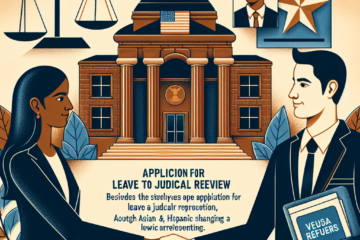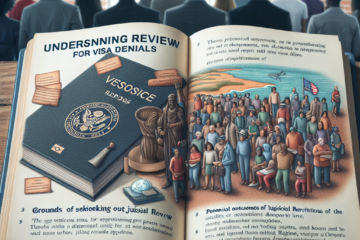Table of contents
Judicial review in the Canadian immigration system is a legal process where the Federal Court reviews a decision made by an immigration officer, board, or tribunal to ensure it was made according to law. This process does not re-assess the facts of your case or the evidence you submitted; instead, it focuses on whether the decision was made in a procedurally fair manner, was within the decision-maker’s authority, and was not unreasonable. Applying for a judicial review of your Canadian immigration application involves challenging a decision made by Immigration, Refugees and Citizenship Canada (IRCC) or the Immigration and Refugee Board (IRB) in the Federal Court of Canada. This process is complex and typically requires the assistance of a lawyer, preferably one who specializes in immigration law. Here’s an outline of the steps involved:
1. Consult an Immigration Lawyer
- Expertise: It’s crucial to consult with a lawyer experienced in Canadian immigration law and judicial reviews. They can assess the merits of your case, advise on the likelihood of success, and navigate the legal procedures.
- Timelines: Immigration judicial reviews have strict timelines. For example, you usually have 15 days after receiving the decision if you’re inside Canada and 60 days if you’re outside Canada to apply for leave (permission) for a judicial review.
2. Apply for Leave to the Federal Court
- Application: Your lawyer will prepare an application for leave, requesting the Federal Court to review the decision. This includes drafting a notice of application that outlines the reasons why the decision should be reviewed.
- Supporting Documents: Along with the notice of application, your lawyer will submit affidavits (sworn statements) and other relevant documents supporting your case.
3. Review by the Federal Court
- Decision on Leave: A Federal Court judge will review your application to decide whether your case should proceed to a full hearing. This decision is based on whether your application appears to have a serious question to be determined.
- Full Hearing: If leave is granted, the court will schedule a full hearing. Both you (through your lawyer) and the respondent (usually the Minister of Citizenship and Immigration) will have the opportunity to present arguments.
4. The Decision
- Possible Outcomes: If the court finds in your favor, it may quash the original decision and order the immigration authority to re-make the decision, taking into account the court’s findings. It’s important to note that the court does not make a new decision on your application but rather returns it to the immigration authority for reconsideration.
5. Follow Next Steps Based on the Outcome
- If Successful: Follow the instructions provided by the court or your lawyer on how the decision will be reconsidered by the immigration authorities.
- If Unsuccessful: Discuss further options with your lawyer, which may include appealing the Federal Court’s decision to the Federal Court of Appeal if there are grounds to do so.
Tips
- Understand the Scope: Judicial reviews focus on the legality of the decision-making process, not on reassessing your application’s merits.
- Prepare Financially: Be aware of the potential costs involved, including legal fees and court costs.
- Manage Expectations: Understand that the judicial review process can be lengthy and outcome uncertain.

Settlement
When your lawyer says your immigration application has “settled” after the judicial review process, it typically means that your case has reached a resolution or conclusion outside of a formal court decision. This can happen in various ways, depending on the specific circumstances of your case. Here are some possibilities of what this could mean:
- Agreement Reached: Both parties (you and the government or immigration authority) might have come to a mutual agreement before the court made a final decision. This could involve concessions or compromises from either side.
- Remedial Action Taken: The immigration authority might have agreed to reconsider your application or take specific actions that address the issues raised during the judicial review process, leading to a resolution of your case.
- Withdrawal or Dismissal: It’s possible that the case was withdrawn by you or dismissed by the court under conditions that you find satisfactory, thereby “settling” the matter from your perspective.
- Positive Outcome: The term “settled” could also imply that the judicial review process led to a favorable outcome for you, such as the revocation of a negative decision and the reinstatement or approval of your immigration application based on procedural fairness or legal grounds.
- No Further Legal Action: By stating that the case is “settled,” your lawyer might be indicating that there are no further legal steps to be taken or that continuing the legal battle is not necessary or advised, given the resolution achieved.
Pax Law can help you!
Our lawyers and consultants are willing, ready, and able to assist you. Please visit our appointment booking page to make an appointment with one of our lawyers or consultants; alternatively, you can call our offices at +1-604-767-9529.



0 Comments